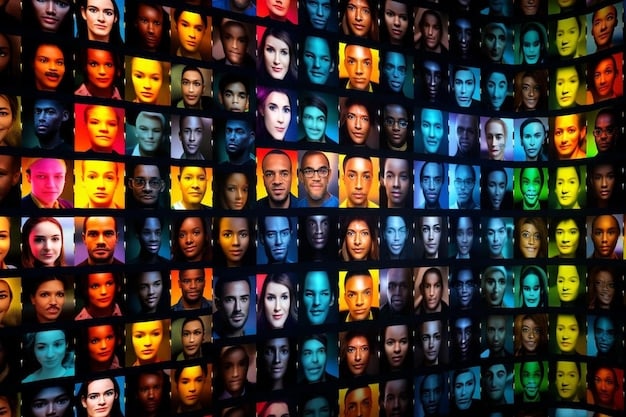Reality TV’s Future: Predictions for the Next 5 Years

The future of reality TV will likely feature increased interactivity, niche content, and a greater focus on diverse representation, adapting to rapidly evolving audience preferences and technological advancements.
The landscape of television is constantly evolving, and no genre feels this shift like reality TV. From its humble beginnings to its current ubiquitous presence, the world of unscripted entertainment is in constant flux. But what does the crystal ball reveal about Reality TV’s Future: Predictions for the Next 5 Years of Unscripted Entertainment? Let’s delve into the trends, technologies, and audience expectations that will shape the next era of reality television.
The Rise of Interactive Reality
One of the most significant trends poised to dominate the coming years is the rise of interactive reality TV. Forget passive viewing—the future is all about engagement.
Voting and Real-Time Influence
Imagine a world where you can directly influence the outcome of a competition in real-time or even impact the storyline of a dating show. This level of interactivity is becoming increasingly feasible.
Platforms are increasingly offering viewers opportunities to make decisions, vote on challenges, and even control character actions. This keeps audiences glued to their screens.
- Direct Voting: Real-time polling allows viewers to decide the fate of contestants.
- Challenge Creation: Social media campaigns enable users to submit ideas for show challenges.
- Character Control: Advanced apps can even let viewers guide the choices of participants.
The incorporation of interactive elements isn’t just a gimmick; it deeply enriches viewer experience. Audience members feel more invested, more entertained, and more loyal to the show.

The Focus on Niche Content and Micro-Communities
Gone are the days when reality TV needed to appeal to everyone. The fragmentation of media, especially the rise of streaming services, is paving the way for niche reality shows targeted at hyper-specific interests.
We’re already seeing the beginnings of this trend with shows centered around niche hobbies and interests. Expect this phenomenon to accelerate.
From Gardening to Gaming
Instead of broad-appeal competitions, think specialized shows about competitive gardening, vintage video game collecting, or extreme couponing.
These niche programs thrive by attracting very specific micro-communities, those with a shared passion and strong willingness to engage with content that speaks directly to their unique interests.
This approach also allows for more meaningful brand integrations. With a highly focused audience comes valuable advertising opportunities for niche products and services.
The Surge in Diverse Representation
For years, diversity has been a buzzword in the entertainment industry. However, as audiences become increasingly conscious of representation, the call for diverse casting and inclusive storytelling in reality TV becomes louder.
The future of reality TV depends on responding to this demand. Shows that actively celebrate diversity aren’t just being ethical; they are setting themselves up for long-term success.
Beyond Tokenism
True representation goes beyond just ticking boxes. It means showcasing a variety of voices, backgrounds, and experiences in an authentic, non-stereotypical manner.
Shows will need to make a conscious effort to feature more LGBTQ+ individuals, minority groups, people with disabilities, and individuals from different socioeconomic backgrounds. And these individuals must be given genuine storylines that resonate with their communities.
Technological Innovations Transforming Reality TV
Technology will play a critical role in redefining reality concepts and enhancing viewer experiences. We’re not just talking about higher-definition cameras; we’re looking at transformative tools like VR, AR, and AI.
Here are some key technological innovations poised to reshape the future of unscripted TV.
Virtual and Augmented Reality Integration
Imagine experiencing a reality show from the eyes of a contestant or exploring a filming location as if you were there. VR and AR technologies make this possible.
- VR Experiences: Offering viewers immersive behind-the-scenes tours and contestant perspectives.
- AR Overlays: Allowing at-home viewers to interact with on-screen elements in real-time.
- Interactive Environments: Creating virtual spaces where audiences can engage with the show’s themes and characters.
Artificial Intelligence
AI will play a crucial role in multiple facets, from streamlining production to personalizing viewer experiences.
AI algorithms could analyze viewer data to personalize content recommendations, predict show successes, and even create interactive storylines based on real-time audience feedback.

The Evolution of Storytelling
Formats and narratives within reality TV are also shifting. As audiences become more sophisticated, so too must the storytelling.
Viewers are craving more authentic, less manufactured drama. They want to connect with real people, genuine struggles, and relatable stories.
From Manufactured Drama to Authentic Narratives
In the past, reality shows thrived on exaggerated conflicts and forced storylines. The future demands more genuine narratives.
This could mean focusing on the everyday challenges of ordinary people, shedding light on social issues, or prioritizing personal growth over competition.
Blurring Lines Between Reality and Fiction
One of the more intriguing trends is the increasing overlap between reality and fiction. Shows that blend scripted and unscripted elements are gaining popularity.
Series that feature actors playing caricatured versions of themselves or docu-series with semi-scripted scenes are examples of this fusion.
Hybrid Formats and the Rise of “Faux Reality”
Hybrid formats offer a unique level of creative control, allowing producers to craft compelling storylines while still capturing spontaneous reactions and interactions.
This approach could lead to more innovative and nuanced storytelling, attracting viewers who might otherwise dismiss traditional reality TV.
| Key Aspect | Brief Description |
|---|---|
| 🗳️ Interactivity | Viewers directly influence shows via real-time voting and challenge creation. |
| 🌱 Niche Content | Specialized reality shows cater to specific interests and micro-communities. |
| 🌟 Diverse Representation | Shows prioritize inclusive casting and authentic, non-stereotypical storytelling. |
| 🤖 Technology | VR, AR, and AI enhance viewer experiences and streamline production. |
FAQ
▼
Interactive features will transform viewers from passive observers to active participants, enhancing engagement and making the experience more personalized. This active role could increase watch times by creating a deeper emotional investment in the show’s outcome.
▼
Expect to see shows focusing on extremely specific hobbies or interests, like competitive birdwatching, advanced-level miniature painting or historical reenactment groups. The more specific the focus, the more effectively it caters to a dedicated micro-community.
▼
Diverse representation expands audience reach and resonates with evolving societal values. Shows that fail to represent a broad range of experiences risk becoming irrelevant and disconnected from their viewers, impacting on the shows popularity.
▼
AI can streamline various stages of production, from identifying potential contestants to analyzing audience engagement. It enables better content personalization, predicting what viewers want, and even generating story arcs. This will enhance overall efficiency.
▼
Hybrid formats will offer creative freedom to craft compelling narratives while keeping the authenticity of unscripted TV. This blending creates room for experimentation, more nuanced plots, and greater relatability, appealing to a broader audience seeking depth.
Conclusion
As we look ahead, the trajectory of reality TV hinges on its capacity to adapt, expand, and innovate. By embracing interactivity, catering to niche interests, championing diversity, harnessing technology, and refining storytelling, unscripted entertainment can not only survive but thrive in an increasingly competitive media landscape.





